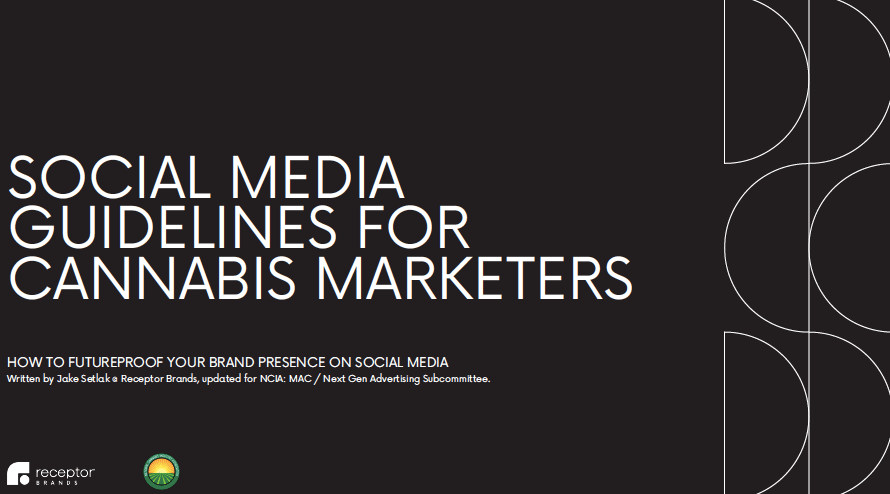Committee Blog: Five Best Practices to Future-Proof Your Cannabis Brand on Social Media

By Jake Setlak, Receptor Brands on behalf of NCIA’s Marketing & Advertising Committee
Social media platforms can be perilous for cannabis businesses. Every brand feels the need to have a presence on social media. Their typical approach is to accumulate followers by posting what you think those followers want to see. Then one day, without notice, those followers — and the platform algorithm’s understanding of why your brand was relevant to them — vanishes. Cannabis brands on social media are surrounded by so much gray area, it’s hard to know what makes your presence vulnerable to risks of suspension or worse. To help brands avoid those gray areas, here are five practices to help cannabis marketers future-proof their brands on social media.
1. Embrace standards.
Brands are held to higher standards on social media than users are. This is especially true for brands in regulated categories like cannabis. Why? Standards help protect against fraud and deception. These protections serve both consumer (users) and commercial (brands, businesses) interests across a wide variety of media channels. Think: truth in advertising and consumer protection laws. Get familiar with the federal, state, and municipal or regional laws that apply to all commercial interests where your cannabis brand operates (or find someone to do this on your behalf).
2. Think about your reputation.
How you behave on social media says a lot about your brand. There’s more than content to consider — bad behavior can permanently discolor your brand’s reputation. Why? Everyone can see what you’re doing. Openly engaging in deceptive practices shows consumers, partners, and regulators that your brand isn’t trustworthy. Those duplicate and back-up Instagram profiles? They signal to the rest of us that you know you’re taking risks. That could be all it takes to inspire someone to flag or report you. Social platforms notoriously rely on users to police the community — if users like you don’t report violations, the platforms tend not to know about them.
3. Safeguard your brand’s presence.
This is worth repeating, regardless of being in cannabis or another category: avoid getting banned. Why? No back-up profile can magically restore lost followers and engagement. When social media platforms decide to allow cannabis brands to use paid advertising, you’ll be locked out. This is why it’s important to set clear goals and objectives for maintaining your brand’s social presence.
Establish a compliance strategy for your social media efforts with three must-haves:
- Social Media Policy for Employees
- Community Management Guidelines & Protocols
- Legal Counsel (professional advice regarding cannabis category regulations, truth-in-advertising standards and consumer protection laws, and social media platform policies)
4. Know what you can say and how you can say it.
Be careful not to misinterpret another brand’s social media activity as setting a precedent for yours. Why? Seeing someone else break the rules is not license or permission for us to break those same rules. Plus, let’s face it — legitimate cannabis brands are already working uphill against prohibition-era prejudices. Know a bad example when you see one, and more importantly know what you can say and how you can say it on social media platforms.
What you can say:
- DO stick to “social” objectives. Take the higher ground. Speak from your brand values, not necessarily what the “insta” know-it-alls might insist. Be a valuable presence in the community, not just more clutter in their feed.
- DON’T antagonize the community. Remember, you’re a commercial interest and held to higher standards than users. It looks bad when brands argue with competitors, followers, or other brands. The Internet is full of trolls who prey and depend on your impulsive responses — even if it isn’t your aim to deceive or misinform, you may already be a target because of the stigma that still comes with cannabis.
How you can say it:
- DO communicate generally. Make observations. Be insightful. Grow your audience. Engage the community.
- DON’T advertise or promote. Explicit calls-to-action (CTAs) like “get”, “find”, “try”, or “buy” aren’t allowed for cannabis, especially on platforms where you can’t guarantee your audience is of a compliant age. This is the same reason you want to avoid depicting or promoting over-consumption.
5. Set the bar higher.
Aim to be the most upstanding citizen in the cannabis community. Why? No one knows when federal legalization will happen or how quickly a platform’s policies will change. This means no one can say it’s too soon to start preparing for such an eventuality!
There are four ways you can start raising the bar right now:
Make content that makes a difference.
Content creation for startups and small businesses doesn’t have to be overwhelming. Start with measurable objectives that justify your content creation process and budget. Scale your efforts toward more effectiveness, not merely more frequent posts. Set aside time to regularly evaluate and optimize your efforts. This is where well-placed focus will go a long way for you. It might take more effort to get beyond the “recommended” or popular approaches, but you will discover that you move faster and spend less when you go with what you know: the meaning and value your brand offers the cannabis community.
Apply paid advertising standard to organic content.
These apply to paid advertising but may in some cases also apply to organic content posted by commercial interests (brands). Platforms change frequently and without warning, so it’s wise to stay current on the policies and guidelines of the platforms you use.
Here are helpful resources for the five social platforms where many brands — regardless of category — typically start on social media. Enforcement may still be a mystery in many cases, but these policies help us understand when a post or profile might venture into gray areas and risk a suspension or worse.
Take cues from similarly regulated categories.
The beverage alcohol industry has multiple efforts to self-regulate advertising and marketing content.
Develop proactive standards that are poised for federal legalization.
Start by getting familiar with the voluntary marketing and advertising codes already emerging in the cannabis industry.
____
Jake Setlak is a founding member and head of Creative Strategy / Brand Experience at Receptor Brands, an agency custom-made for cannabis that transforms relationships between cannabis brands and their customers. Prior to his work in cannabis, Jake spent 20 years guiding the digital transformation of some of the world’s biggest brands and their advertising agencies. He’s worked in social media channels since before they were called “social media” and invented the Facebook Comment Ad format (now known as the boosted or promoted post). Jake is a member of NCIA’s Education Committee but produced this content while a member of the Marketing & Advertising Committee and serving on its Next-Generation Advertising subcommittee.
Member Blog: Does Your Cannabis Brand Need Social Media? Yes, But Not For the Reasons You Think

By Aaron Rosenbluth, Hybrid Marketing Co
Every cannabis brand needs social media. But, the reasons to be on social media, and how you should approach your accounts might surprise you.
Social media is a powerful tool for all businesses today. Even in the cannabis industry, where most paid advertising opportunities – including paid social – are off the table.
It’s an effective way to communicate with customers directly. Social media lets your cannabis brand or dispensary start meaningful conversations – it’s a place to develop and nurture a community. But should you look at social media as a primary business driver? Probably not; hear me out.
Five years ago, when I started managing social media accounts for cannabis brands, organic engagement wasn’t easy, but it was easier than it is today. Marketers (like me) remember the era of chronological Instagram feeds and simplified Facebook algorithms fondly. Five years ago, getting organic attention from your followers was more straightforward. It was also easier to build an audience quickly.
Strict regulations are a constant battle for cannabis businesses marketing on social media. We’re violating every platform’s terms of service and community guidelines just by being there. Every cannabis brand wants social dominance. I’m here to deliver unfortunate news; social media dominance is off the table for most of you.
Today, you can only expect to reach about 3% of your audience on most social media platforms. And that’s if your content is excellent. But even with amazing content, algorithms are your enemy, and hashtags only get you so far.
It can feel like an impossible challenge. We’re tasked with bolstering brands but walk a tightrope of rules to keep posts and accounts from getting the boot.
Do cannabis brands still need to be on social media? Yes. Here’s why.
You can access a limitless direct-to-consumer digital platform if you can manage to grow and maintain a social media following. But, of course, it’ll take time to build an engaged community (for many of you, it’ll take years of hard and consistent work), and you need to be realistic – don’t put all of your cannabis marketing eggs in the social media basket; there are other ways (email and programmatic advertising for example).
Still, social media is a business necessity today, just like printer cartridges or desk chairs. You must be there – even if the task is seemingly impossible.
What makes excellent social media content?
Every marketing “expert” on the internet will tell you the key to social media success is excellent content. And that’s true. But, what makes for awesome content is relatively subjective – it’s not for you or me to decide. So, who gets to decide what makes terrific content? Your customers, that’s who.
How do you determine if your customers think your content is excellent? They’ll reward you with engagement. And engagement is virtually the only thing almighty social media algorithms care about.
Maybe your customers love ridiculous memes; perhaps they prefer higher-brow lifestyle content. If you run a dispensary, your customers might love seeing their favorite budtenders highlighted on your feeds. If you’re a cultivator, your customers probably think drool-worthy strain content is excellent (be careful, Instagram is advanced enough to find flower images, and that violates TOS and community guidelines).
Here are a few social media post types you should consider:
- Expert Budtender Recommendations
- Cultivation Behind-the-Scenes
- Aspirational Lifestyle Imagery and Content
- Humorous Memes for Cannabis Enthusiasts
- General Cannabis Education
- Product Education
- Consumption Tips and Guidelines
You need to deeply understand your customers (that’s why we’re persona development sticklers) and craft a content strategy explicitly designed for engagement. Of course, I’m vastly oversimplifying this process – it takes time and a lot of testing to determine what will work best for your cannabis brand. But the results are often worth the work. Let your customers tell you what they want.
Even with excellent content, you need to be realistic.
I’m going to break some hard news to you – even with genuinely excellent content, you can still really only expect to reach around 3% (as I mentioned earlier) of your total audience. So whoever told you that organic engagement on social media is easy lied to you.
Most people think there’s one overarching algorithm controlling what we see on our social media feeds. But, in the case of Instagram, for example, several algorithms work together, making tiny decisions in real-time to determine the posts you see.
Adam Mosseri (head of Instagram) talks about how their algorithms work in a recent blog:
“One of the main misconceptions we want to clear up is the existence of “The Algorithm.” Instagram doesn’t have one algorithm that oversees what people do and don’t see on the app. We use a variety of algorithms, classifiers, and processes, each with its own purpose. We want to make the most of your time, and we believe that using technology to personalize your experience is the best way to do that.
When we first launched in 2010, Instagram was a single stream of photos in chronological order. But as more people joined and more was shared, it became impossible for most people to see everything, let alone all the posts they cared about. By 2016, people were missing 70% of all their posts in Feed, including almost half of posts from their close connections. So we developed and introduced a Feed that ranked posts based on what you care about most.
Each part of the app — Feed, Explore, Reels — uses its own algorithm tailored to how people use it. People tend to look for their closest friends in Stories, but they want to discover something entirely new in Explore. We rank things differently in different parts of the app, based on how people use them.”
Instagram wants to personalize content for users, so it’s constantly making small decisions to reach its goal. Your job (and ours, as marketers) is to understand our customers deeply enough to create unique personalized experiences (I prefer to use the word experience over content in this scenario). Still, the algorithms pose a challenge which is why you need to understand that it’s going to take a lot of time, a lot of trial and error, and more content than you think you can possibly create in a lifetime to build and manage a loyal – and engaged – community.
It’s not impossible, but it’s not easy – many of you will fail. But still, you must be there because your customers expect you to show up for them in the places they hang out digitally. Of course, it doesn’t hurt to have the support of an experienced social media marketing team.
 Aaron is Hybrid Marketing Co‘s Content Director, and he loves to write blogs. He’s written so many blogs that he’s lost count. And beyond his skills as a copywriter and storyteller, he’s an obsessive reader and researcher. Aaron writes on subjects ranging from cannabis to collaboration, social equity to HR software, interior design to cybersecurity. His words attract, engage, educate, and convert. Btw, Aaron hates the phrase “content is king” (even though content is king – and queen).
Aaron is Hybrid Marketing Co‘s Content Director, and he loves to write blogs. He’s written so many blogs that he’s lost count. And beyond his skills as a copywriter and storyteller, he’s an obsessive reader and researcher. Aaron writes on subjects ranging from cannabis to collaboration, social equity to HR software, interior design to cybersecurity. His words attract, engage, educate, and convert. Btw, Aaron hates the phrase “content is king” (even though content is king – and queen).
Hybrid Marketing Co is a Denver-based branding and marketing agency that specializes in building custom strategies that supercharge growth and drive revenue. Working with brands and businesses across the U.S. and Canada, Hybrid’s partners run the full-spectrum of the cannabis world including dispensaries, manufacturers, cultivators, and ancillary businesses. Visit hybridmarketingco.com to learn more about the Hybrid approach.
Guest Post: 4 Easy Ways To Make Social Media Work For Your Cannabusiness
by Alexa Divett, Alexa Divett, LLC
 Hopefully by now you know the importance of building your brand’s presence on social media. However, there may be days when you ask yourself, “WTF am I doing?”
Hopefully by now you know the importance of building your brand’s presence on social media. However, there may be days when you ask yourself, “WTF am I doing?”
Oftentimes social can seem overwhelming and confusing. For example, you may log onto Pinterest to try to figure it out and three hours later all you’ve found is an amazing recipe for brownies (marijuana optional).
Most cannabis business owners have got the “weed porn” portion of social down – meaning they know how to post pictures of weed on Instagram and Facebook but don’t worry about much else.
Well, I’m here to tell you that there is a lot more to social than weed porn.
And… weed porn is one of the big red flags for Facebook and Instagram and is a great way to get your account shut down.
If you are ignoring a larger content marketing strategy and only posting content that is full of hype and sales, you are not only likely to get your account shut down, but you are also very likely to turn off your prospective customers.
 Thanks in part to an over-saturation of weed porn and of course constantly changing algorithms (Facebook, Instagram… who’s next?), there is a need for a robust strategy that can evolve.
Thanks in part to an over-saturation of weed porn and of course constantly changing algorithms (Facebook, Instagram… who’s next?), there is a need for a robust strategy that can evolve.
Like most marketing strategies, this can seem like a ton of work and may not have your full attention.
So on that note, here are four easy ways to maximize your social presence and make social media marketing work for you (beyond weed porn and pot brownies).
Choose your platform(s).
You don’t need to be an expert at every channel. Pick the two or three channels where you know your audience hangs out and master them.
Facebook, Instagram, and Twitter are the big three that you should know how to use strategically. There are other cannabis social channels such as MassRoots but they don’t have the impact and reach that the big three have, at least not yet.
Make sure your imagery matches your brand’s promise and is consistent.
From your logo to your profile name and picture, everything across your social channels should be instantly recognizable and represent your brand’s promise. Make sure you are following your branding guidelines and using the correct fonts and colors to design your pages and establish your brand.
Create engagement with valuable and shareable content.
It’s easy to fall into the trap of posting things that you and your employees like without really knowing if your audience feels the same way. Make sure you are creating content that your audience is excited about and eager to share. One of the easiest ways to determine what content your audience likes is by tracking the likes, comments, and shares on your posts and by watching what other successful brands within your niche are doing.
Engage with your followers by taking part in the discussion.
One of the quickest ways to create your tribe is to socialize your content. The easiest way to do this is to reach out to industry influencers and mention their names in your posts. Once you do that you can start to create a relationship with the key players in the industry and inspire them to connect with you and share your content.
Again, the content needs to be fresh, relevant and exciting.
Weed porn alone won’t cut it.
 As a successful entrepreneur, longtime marijuana advocate and medical grower, Alexa Divett understands the unique needs of the cannabis industry. Alexa is the founder of Alexa Divett LLC, a business coaching and consulting company helping cannabis business owners achieve success through the implementation of sound business practices and time-tested marketing techniques.
As a successful entrepreneur, longtime marijuana advocate and medical grower, Alexa Divett understands the unique needs of the cannabis industry. Alexa is the founder of Alexa Divett LLC, a business coaching and consulting company helping cannabis business owners achieve success through the implementation of sound business practices and time-tested marketing techniques.
Alexa’s achievements include co-founding Maya Media Collective, a Portland, Oregon-based creative firm that specializes in the cannabis industry, and writing the “Marijuana Millions” Ebook series, which The Weedblog called the best marijuana-branding book to date. Additionally, Alexa speaks about marketing and branding cannabis businesses at local and national events. Alexa’s products and presentations on starting and running successful cannabis businesses have made her an in-demand and innovative expert in the cannabis business world.



 Aaron is
Aaron is Hopefully by now you know the importance of building your brand’s presence on social media. However, there may be days when you ask yourself, “WTF am I doing?”
Hopefully by now you know the importance of building your brand’s presence on social media. However, there may be days when you ask yourself, “WTF am I doing?”  Thanks in part to an over-saturation of weed porn and of course constantly
Thanks in part to an over-saturation of weed porn and of course constantly  As a successful entrepreneur, longtime marijuana advocate and medical grower, Alexa Divett understands the unique needs of the cannabis industry.
As a successful entrepreneur, longtime marijuana advocate and medical grower, Alexa Divett understands the unique needs of the cannabis industry.
Follow NCIA
Newsletter
Facebook
Twitter
LinkedIn
Instagram
News & Resource Topics
–
This Just In
Committee Blog: Streamlining Cannabis Ownership Changes – Time for a Smarter Approach
Committee Blog: How to Build a Cannabis Business Continuity Plan Before the Next Natural Disaster